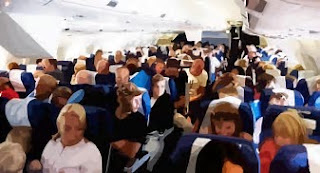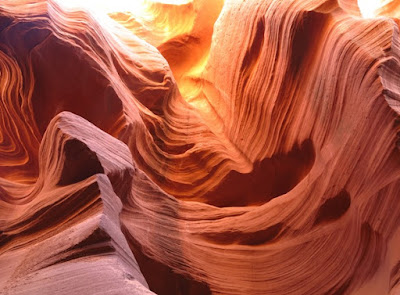Mountains, seashore, rainforest.
It's hard to imagine that one park can encompass such geographical diversity. But that's what attracts visitors to Olympic National Park in Washington state. In addition to its national park status, this million-acre park has been designated as both a World Heritage Site and an International Biosphere Reserve.
After spending several days in the mountainous regions of the park, we headed out to explore old-growth rainforests.
 |
| Fall colors just beginning to show in Olympic National Park |
 |
Hoh Rain Forest is one of three ecological regions of
Olympic National Park. |
This is a temperate (not tropical) rain forest,
which means it is shady and cooler in temperature but still immensely verdant.
Among the thick foliage—a tangle of low-hanging drooping branches curving
upward in search of sunlight—we saw many different kinds of mosses in various
shades of green.
 |
| The greenness is simply incredible. |
 |
| Thick ferns along the path |
Tree trunks, fallen branches, stumps, and ground are covered
in yellow-green, emerald green, blackish-green, and silvery green plant life. Staggered
ferns covered the ground, pencil tree trunks grew upward, and vines and mosses
wrapped around other plants in a symbiotic relationship known as plants growing on plants.
Everywhere we see the cycle of nature: growth, death,
replenishing. Fallen trees provide food for the next generation of plants and for
forest critters that chew on decaying wood.
Our hiking goal was the waterfall on Hoh
River Trail. Surprisingly, few folks walking on the trail seemed to know about
it, but after more than two hours we found the waterfall. At the water’s edge, I splashed
my hands to check the temperature—it was quite cool for early September.
 |
| The elusive waterfall |
The weather was damp, with rain drops dripping from tree
branches long after actual rain had stopped. We took our time to enjoy and photograph the immense variety of
flora, including 24 species of plants found nowhere else in the world. The path
was not too difficult, just long and messy with enough diversions to slow our
pace.
On the return we stopped just off the trail, found
“natural” seats (fallen tree trunks) and scarfed down our packed lunches. As for
wildlife, we only saw one elk in the woods, although surely there were more staying out of sight.
 |
| I perched on a tree trunk to eat my sandwich. |
After leaving the rain forest and heading down the Washington coast later that day, we stopped at Ruby Beach, so-called because tiny bits of garnet crystals in the sand give it a
rosy glow in sunlight. At this scenic beach just off U.S. 101, the shore
broadened into a wide expanse of glistening sand as the afternoon tide retreated from the
rugged coastline.
 |
| Amazing sea stacks at Ruby Beach |
Children were climbing on large sea stacks, rock
formations in the water that shelter a variety of plant and animal life like crabs,
anemones, mussels, and barnacles. Tidal pools also host animals tough and
adaptable enough to live in the harsh conditions. The smooth sand, just
dampened by the receding tide, provided amazing reflections that are among our
favorite photographs.
 |
| Beautiful reflections in the outgoing tide |
Back at Kalaloch Lodge cute bunny rabbits scampering
around the backyard of our cabin made us chuckle. The beach just below the cliff on which the cabin was perched invited us to take a stroll.
 |
| Glorious sunset at Kalaloch Beach |
Sea breezes and the setting sun created lovely striations
of pink, yellow, and blue in the sky above the water—the perfect ending to
another day of discovery.




 Accommodations also include Seacrest
House which offers motel-style rooms with private patios and balconies that
face the splendid, often thundering, beaches. Nestled in a conifer forest just
a short walk from Kalaloch's Main Lodge, Seacrest is the most secluded.
Accommodations also include Seacrest
House which offers motel-style rooms with private patios and balconies that
face the splendid, often thundering, beaches. Nestled in a conifer forest just
a short walk from Kalaloch's Main Lodge, Seacrest is the most secluded. 


































